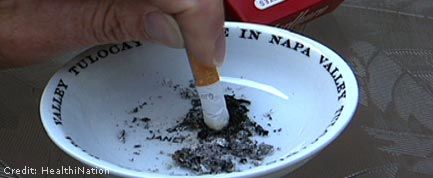Smokers' Brains Can Control Cravings

Smokers, take heart: A new study finds that even strong cravings for cigarettes can be curbed. You just have to use the right parts of your brain.
Using a technique called functional magnetic resonance imaging (fMRI), researchers watched the brains of smokers as they were shown images of cigarettes and food. When the smokers tried to resist their cravings for their objects of desire, parts of their brain associated with control of emotion lit up with activity, while craving-related areas quieted.
"This shows that smokers can indeed control their cravings, they just need to be told how to do it," lead researcher Hedy Kober, assistant professor of psychiatry at the Yale School of Medicine, said in a statement.
Smoking on the brain
Kober and colleagues tackled the study of cravings because previous research has found that the presence of these strong urges is one of the best predictors for relapse in substance abusers. As a result, many recovery programs use a method called cognitive-behavioral therapy to retrain the brain in the face of temptation. Often, these strategies involve tamping down emotion and thinking logically about the long-term consequences of giving in to the craving.
While cognitive-behavioral therapy is often successful for helping people quit smoking, no one knew exactly which brain areas were involved in this craving-reduction process. Previous work pointed to a few key areas, including the prefrontal cortex, an area of the brain behind the forehead that's known to be important in cognitive control. Another area of interest, the ventral striatum, is buried deep in the forebrain. This region activates when people feel cravings for a drug.
To test their theory that these areas are important in resisting cravings, the researchers had 21 smokers try to resist cravings triggered by the images of cigarettes and food. The smokers were told to think of the long-term negative consequences of giving in.
Sign up for the Live Science daily newsletter now
Get the world’s most fascinating discoveries delivered straight to your inbox.
Brain curbs cravings
As it turned out, the smokers had stronger cravings for cigarettes than food, but they were able to manage both cravings equally, reducing each by about one-third as shown by decreases in activity in the craving region of the brain. As they successfully resisted their cravings, the smokers' emotional regulation areas in the prefrontal cortex showed increased blood flow, indicating greater activity. Meanwhile, the ventral striatum and other emotional areas tied to cravings such as the amygdala (an almond-shaped structure deep in the brain), showed less activity. The pattern held whether the participants were fighting the desire for food or cigarettes.
"We saw really nicely that there's this pathway," said Kevin Ochsner, a psychologist at Columbia University and senior author of the study. "The frontal lobe comes on, the striatum goes off, and then craving goes off."
Many people assume there is something wrong with the brains of addicts that makes them unable to resist cravings, Ochsner said, but the fact that smokers were able to equally control their cravings for addictive tobacco and non-addictive food suggests that something else is going on. More likely, smokers either lack strong enough motivation or effective strategies to quit, he said. The researchers' next step is to examine the brains of smokers who are using cognitive-behavioral strategies to quit and to see if something in their brain activity can predict their success.
The paper was published in the Proceedings of the National Academy of Sciences.
- 5 Habits You Should Still Quit
- 10 Easy Paths to Self-Destruction
- Smoking's Many Myths Explained

Stephanie Pappas is a contributing writer for Live Science, covering topics ranging from geoscience to archaeology to the human brain and behavior. She was previously a senior writer for Live Science but is now a freelancer based in Denver, Colorado, and regularly contributes to Scientific American and The Monitor, the monthly magazine of the American Psychological Association. Stephanie received a bachelor's degree in psychology from the University of South Carolina and a graduate certificate in science communication from the University of California, Santa Cruz.











